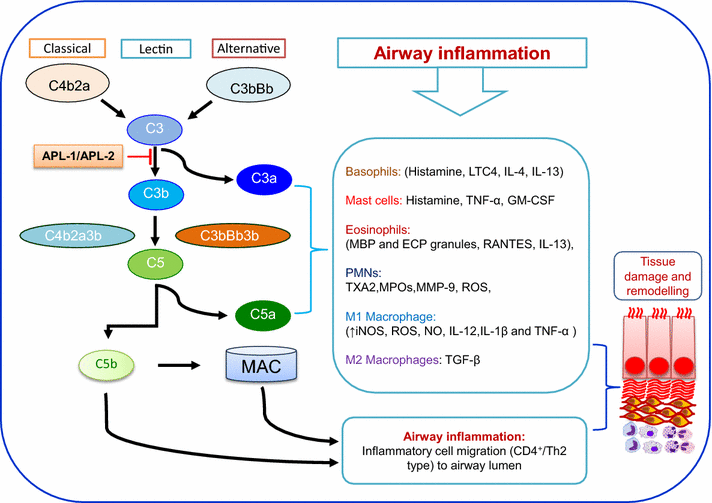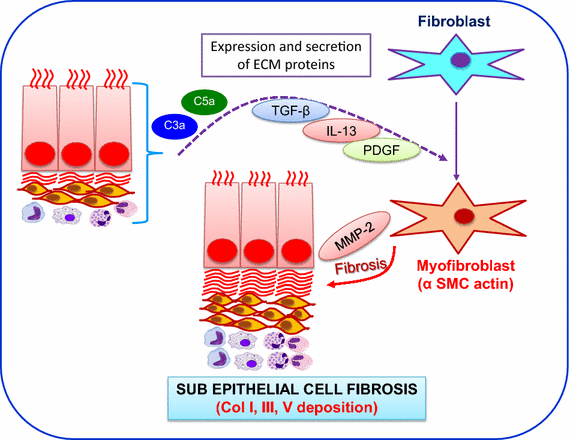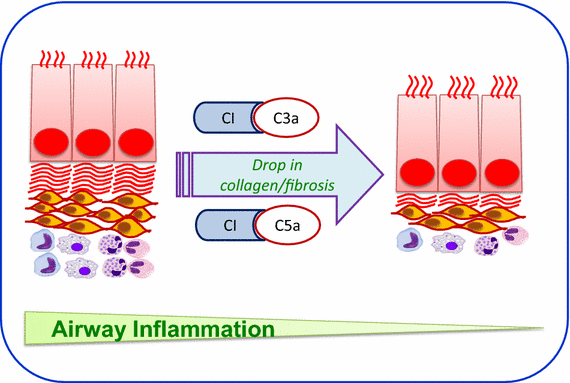Complement mediators: key regulators of airway tissue remodeling in asthma
- PMID: 26289385
- PMCID: PMC4544802
- DOI: 10.1186/s12967-015-0565-2
Complement mediators: key regulators of airway tissue remodeling in asthma
Abstract
The complement mediators are the major effectors of the immune balance, which operates at the interface between the innate and adaptive immunity, and is vital for many immunoregulatory functions. Activation of the complement cascade through the classical, alternative or lectin pathways thus generating opsonins like C3b and C5b, anaphylatoxins C3a and C5a, chemotaxin, and inflammatory mediators, which leads to cellular death. Complement mediators that accelerate the airway remodeling are not well defined; however, an uncontrolled Th2-driven adaptive immune response has been linked to the major pathophysiologic features of asthma, including bronchoconstriction, airway hyperresponsiveness, and airway inflammation. The mechanisms leading to complement mediated airway tissue remodeling, and the effect of therapy on preventing and/or reversing it are not clearly understood. This review highlights complement-mediated inflammation, and the mechanism through it triggers the airway tissue injury and remodeling in the airway epithelium that could serve as potential targets for developing a new drug to rescue the asthma patients.
Figures



Similar articles
-
Anaphylatoxins: their role in bacterial infection and inflammation.Immunol Res. 2007;37(3):161-75. doi: 10.1007/BF02697367. Immunol Res. 2007. PMID: 17873401 Review.
-
Regulation and function of anaphylatoxins and their receptors in allergic asthma.Mol Immunol. 2017 Apr;84:51-56. doi: 10.1016/j.molimm.2016.11.013. Mol Immunol. 2017. PMID: 27916272 Review.
-
Complement in asthma: sensitivity to activation and generation of C3a and C5a via the different complement pathways.Transl Res. 2006 Oct;148(4):157-63. doi: 10.1016/j.trsl.2006.05.004. Transl Res. 2006. PMID: 17002917
-
The anaphylatoxins bridge innate and adaptive immune responses in allergic asthma.Mol Immunol. 2004 Jun;41(2-3):123-31. doi: 10.1016/j.molimm.2004.03.019. Mol Immunol. 2004. PMID: 15159057 Review.
-
Complement factors C3a and C5a are increased in bronchoalveolar lavage fluid after segmental allergen provocation in subjects with asthma.Am J Respir Crit Care Med. 2001 Nov 15;164(10 Pt 1):1841-3. doi: 10.1164/ajrccm.164.10.2010096. Am J Respir Crit Care Med. 2001. PMID: 11734433
Cited by
-
Trends of therapy in the treatment of asthma.Ther Adv Respir Dis. 2023 Jan-Dec;17:17534666231155748. doi: 10.1177/17534666231155748. Ther Adv Respir Dis. 2023. PMID: 36942731 Free PMC article. Review.
-
IL-13 and IL-13-induced periostin levels are specifically decreased in patients following endoscopic sinus surgery for chronic rhinosinusitis.J Allergy Clin Immunol. 2024 May;153(5):1292-1305. doi: 10.1016/j.jaci.2023.11.922. Epub 2023 Dec 28. J Allergy Clin Immunol. 2024. PMID: 38157944 Free PMC article.
-
Complement C1q essential for aeroallergen sensitization via CSF1R+ conventional dendritic cells type 2.J Allergy Clin Immunol. 2023 Nov;152(5):1141-1152.e2. doi: 10.1016/j.jaci.2023.07.016. Epub 2023 Aug 8. J Allergy Clin Immunol. 2023. PMID: 37562753 Free PMC article.
-
The Value of Targeting Complement Components in Asthma.Medicina (Kaunas). 2020 Aug 12;56(8):405. doi: 10.3390/medicina56080405. Medicina (Kaunas). 2020. PMID: 32806638 Free PMC article.
-
Regulatory T cells mediated immunomodulation during asthma: a therapeutic standpoint.J Transl Med. 2020 Dec 2;18(1):456. doi: 10.1186/s12967-020-02632-1. J Transl Med. 2020. PMID: 33267824 Free PMC article. Review.
References
-
- Thangam EB, Venkatesha RT, Zaidi AK, Jordan-Sciutto KL, Goncharov DA, Krymskaya VP, et al. Airway smooth muscle cells enhance C3a-induced mast cell degranulation following cell-cell contact. FASEB J. 2005;19:798–800. - PubMed
-
- Barnes PJ, Chung KF, Page CP. Inflammatory mediators of asthma: an update. Pharmacol Rev. 1998;50:515–596. - PubMed
Publication types
MeSH terms
Substances
LinkOut - more resources
Full Text Sources
Other Literature Sources
Medical

